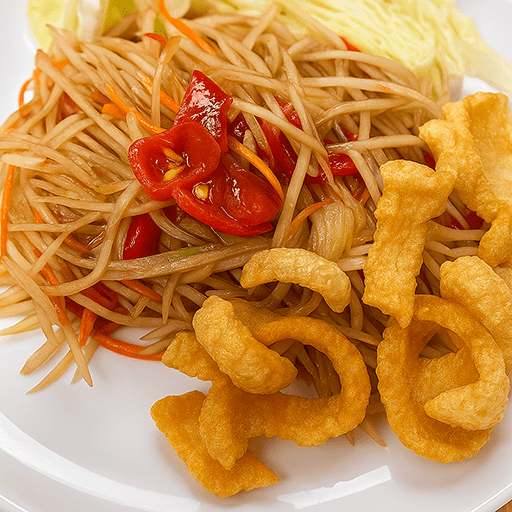Thailand is known worldwide for its vibrant, aromatic, and unforgettable food. But “Thai cuisine” isn’t one single cooking style—it’s a mosaic of regional flavors shaped by history, geography, and culture. From the cool mountains of Chiang Mai to the tropical coasts of Phuket and the rice fields of Isaan, each region has its own personality on the plate.
Whether you’re traveling through Thailand or simply curious about the country’s food culture, here’s a delicious deep dive into the differences between Northern, Central, Southern, and Isaan Thai cuisines.
1. Northern Thai Cuisine (Lanna Cuisine)
Regions: Chiang Mai, Chiang Rai, Lampang, Mae Hong Son
Flavor profile: Mild heat, herbal, earthy, comforting
Influences: Burmese, Yunnanese, Shan
Northern Thai food uses fewer chilies and less sugar than other regions, favoring warm spices, aromatic herbs, and rich, slow-cooked dishes. Sticky rice is the daily staple.
Signature Dishes
-
Khao Soi – Creamy curry noodle soup topped with crispy noodles
-
Nam Prik Ong – Tomato-pork chili dip served with vegetables
-
Sai Ua – Spicy herb-packed grilled sausage
-
Gaeng Hung Lay – Burmese-style pork belly curry with tamarind & ginger
What Makes It Unique
Northern food leans heavily on fresh herbs, mild curries, and grilled meats. The flavors are deep and complex but rarely fiery.
2. Central Thai Cuisine
Regions: Bangkok, Ayutthaya, Lopburi
Flavor profile: Balanced—sweet, salty, sour, spicy
Influences: Royal Thai cuisine, Chinese, Portuguese
Central Thailand—home of Bangkok—offers the most globally recognized Thai dishes. This region excels in balancing all four major Thai tastes in one plate.
Signature Dishes
-
Pad Thai – Stir-fried noodles with tamarind and peanuts
-
Tom Yum Goong – Spicy–sour shrimp soup
-
Green Curry (Gaeng Keow Wan) – Creamy coconut curry with herbs
-
Massaman Curry – Aromatic Muslim-influenced curry
What Makes It Unique
Central cuisine uses coconut milk, palm sugar, fragrant herbs, and intricate cooking techniques derived from royal kitchens. It’s refined, balanced, and crowd-pleasing.
3. Southern Thai Cuisine
Regions: Phuket, Krabi, Songkhla, Surat Thani
Flavor profile: Very spicy, bold, tangy, coconut-rich
Influences: Malaysian, Indonesian, Muslim culinary traditions
Southern Thailand is known for its fiery dishes, abundant seafood, and curries that pack a punch. Fresh turmeric, coconut milk, and seafood dominate the region’s cooking.
Signature Dishes
-
Gaeng Som (Sour Curry) – Tart, spicy curry with fish
-
Khao Yam – Southern rice salad with herbs
-
Khua Kling – Dry stir-fried minced meat with curry paste
-
Massive fresh seafood platters
What Makes It Unique
Southern Thai cuisine is the spiciest in Thailand. The region’s proximity to the ocean and Malay Peninsula creates a tropical flavor profile—zesty, turmeric-heavy, and seafood-forward.
4. Isaan Thai Cuisine (Northeastern)
Regions: Udon Thani, Khon Kaen, Ubon Ratchathani, Nakhon Ratchasima
Flavor profile: Spicy, sour, rustic, grilled
Influences: Lao cuisine
Isaan food is beloved across Thailand for its bold, rustic flavors. Sticky rice is the core carbohydrate, eaten by hand and paired with grilled meats and punchy salads.
Signature Dishes
-
Som Tum – Papaya salad with lime, chilies, and fish sauce
-
Larb – Spicy minced meat salad with roasted rice powder
-
Gai Yang – Grilled marinated chicken
-
Grilled beef or pork with jeow dipping sauces
What Makes It Unique
Isaan dishes emphasize chilies, lime, fermented fish sauce (pla ra), and charcoal grilling. The cuisine is humble, hearty, and intensely flavorful.
Regional Comparison at a Glance
| Region | Heat Level | Main Carbs | Key Ingredients | Signature Style |
|---|---|---|---|---|
| Northern | Mild | Sticky rice | Herbs, ginger, turmeric | Comforting, aromatic |
| Central | Medium | Jasmine rice | Coconut milk, palm sugar | Balanced, refined |
| Southern | Very spicy | Jasmine rice | Turmeric, seafood, coconut | Fiery, tangy, intense |
| Isaan | Spicy to very spicy | Sticky rice | Chilies, lime, pla ra | Rustic, grilled, bold |
Final Thoughts
Thailand’s regional cuisines showcase the country’s diversity and creativity. Whether you’re savoring the gentle warmth of Northern curries, the classic balance of Central dishes, the fiery Southern heat, or the rustic charm of Isaan food, each region tells a story through its flavors.
Exploring Thai cuisine region by region isn’t just tasting different dishes—it’s discovering the history, culture, and soul of Thailand.
